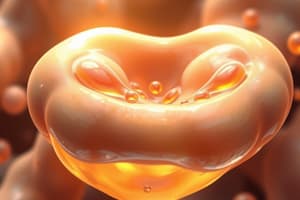Podcast
Questions and Answers
What are triglycerides from plants primarily characterized by?
What are triglycerides from plants primarily characterized by?
- Being colorless and tasteless
- A higher melting point
- Being solid at room temperature
- A higher proportion of unsaturated fatty acids (correct)
Which type of fat is generally considered bad for heart health?
Which type of fat is generally considered bad for heart health?
- Trans fats
- Polyunsaturated fatty acids (PUFA)
- Saturated fatty acids (SFA) (correct)
- Monounsaturated fatty acids (MUFA)
What is the dietary source of essential fatty acids?
What is the dietary source of essential fatty acids?
- They can be synthesized in adequate amounts in the body
- They are only found in animal fats
- They are primarily found in processed foods
- They must be obtained from dietary sources (correct)
Which of the following oils is considered to be high in omega-6 fatty acids?
Which of the following oils is considered to be high in omega-6 fatty acids?
What reaction involves the breaking down of triglycerides?
What reaction involves the breaking down of triglycerides?
What is the state of most plant triglycerides at room temperature?
What is the state of most plant triglycerides at room temperature?
Which type of fatty acids is abundant in a typical Inuit diet?
Which type of fatty acids is abundant in a typical Inuit diet?
What is the effect of hydrogenation on triglycerides?
What is the effect of hydrogenation on triglycerides?
What is an emulsion?
What is an emulsion?
What differentiates sphingolipids from glycerophospholipids?
What differentiates sphingolipids from glycerophospholipids?
What is lecithin also known as?
What is lecithin also known as?
Which of the following best describes cholesterol?
Which of the following best describes cholesterol?
What is the primary role of triacylglycerols?
What is the primary role of triacylglycerols?
What constitutes the basic structure of steroids?
What constitutes the basic structure of steroids?
What replaces one of the fatty acids in sphingolipids?
What replaces one of the fatty acids in sphingolipids?
What is formed during complete hydrolysis of triglycerides?
What is formed during complete hydrolysis of triglycerides?
Which fatty acid is a major starting material for eicosanoids?
Which fatty acid is a major starting material for eicosanoids?
Which lipids are crucial components of cell membranes?
Which lipids are crucial components of cell membranes?
What is produced during the saponification of triglycerides?
What is produced during the saponification of triglycerides?
What occurs during partial hydrolysis of triglycerides?
What occurs during partial hydrolysis of triglycerides?
Which of the following fatty acids is necessary for normal brain development?
Which of the following fatty acids is necessary for normal brain development?
What is a likely outcome of a diet lacking essential fatty acids?
What is a likely outcome of a diet lacking essential fatty acids?
What are fat substitutes primarily designed to do?
What are fat substitutes primarily designed to do?
Under basic conditions, what is produced from the hydrolysis of triglycerides?
Under basic conditions, what is produced from the hydrolysis of triglycerides?
What is a characteristic feature of leukotriene A4?
What is a characteristic feature of leukotriene A4?
What defines saponifiable lipids?
What defines saponifiable lipids?
Which substance is an example of a nonsaponifiable lipid?
Which substance is an example of a nonsaponifiable lipid?
What is the primary function of waxes in biological systems?
What is the primary function of waxes in biological systems?
What is the chemical classification of waxes?
What is the chemical classification of waxes?
Which of the following statements about lanolin is accurate?
Which of the following statements about lanolin is accurate?
What process leads to the formation of esters in waxes?
What process leads to the formation of esters in waxes?
Which characteristic is true for nonsaponifiable lipids?
Which characteristic is true for nonsaponifiable lipids?
What is the role of polyunsaturated fatty acids in plant phospholipids?
What is the role of polyunsaturated fatty acids in plant phospholipids?
Which type of lipoprotein is primarily responsible for transporting triglycerides from the digestive tract?
Which type of lipoprotein is primarily responsible for transporting triglycerides from the digestive tract?
What is the function of cholesterol in the cell membrane?
What is the function of cholesterol in the cell membrane?
Which type of lipoprotein is often referred to as 'good cholesterol'?
Which type of lipoprotein is often referred to as 'good cholesterol'?
What is the significance of kinks in the fatty acid chains of lipids?
What is the significance of kinks in the fatty acid chains of lipids?
How can HDL and LDL levels in the blood be used in health assessments?
How can HDL and LDL levels in the blood be used in health assessments?
What type of complex is formed by carbohydrates attached to proteins in the cell membrane?
What type of complex is formed by carbohydrates attached to proteins in the cell membrane?
What is TRUE about propensities of lipoproteins?
What is TRUE about propensities of lipoproteins?
Flashcards are hidden until you start studying
Study Notes
### Lipids
- Lipids are a diverse group of naturally occurring molecules that are grouped together due to their solubility in nonpolar solvents.
- Lipids are typically composed of hydrocarbons.
- Lipids can be classified as fats, oils, waxes, steroids, and phospholipids.
- Fats and oils are triglycerides.
- Triglycerides are esters of glycerol and fatty acids.
Essential Fatty Acids
- Essential fatty acids are those that the human body cannot synthesize and must be obtained through the diet.
- Two of the most important essential fatty acids are linoleic acid and linolenic acid.
- Linoleic acid (18:2) can be converted into arachidonic acid (20:4).
- Linolenic acid (18:3) can be converted into EPA (20:5) and DHA (22:6)
- Arachidonic acid is a key starting material for eicosanoids, which regulate blood pressure, clotting and other important functions.
- EPA and DHA are important constituents of the brain and are necessary for normal brain development.
- Essential fatty acid deficiencies can result in red and irritated skin, infections, dehydration, and liver abnormalities.
### Triglycerides
- Triglycerides can come from plant and animal sources.
- Triglycerides from plants tend to have a higher proportion of unsaturated fatty acids.
- Plant-based triglycerides are typically liquids at room temperature and are called oils.
- Examples of plant-based oils include corn oil, canola oil, peanut oil, and olive oil.
- Triglycerides from animals tend to have a higher melting point.
- Examples of animal-based fats include butter, lard, and bacon grease.
- Saturated fatty acids (SFAs) are generally considered bad for heart health.
- Monounsaturated fatty acids (MUFAs) are generally considered good for heart health.
- Polyunsaturated fatty acids (PUFAs) can be either good or bad for heart health depending on the type.
- Omega-3 fatty acids, found primarily in fish, are generally considered good for health while Omega-6 fatty acids, found in plant oils, are considered bad for heart health.
- Pure fats and oils are colorless, odorless, and tasteless.
Chemical Reactions of Triacylglycerols
- Triglycerides can undergo several chemical reactions, including hydrolysis, hydrogenation, oxidation, and base-catalyzed hydrolysis (saponification).
Hydrolysis
- Hydrolysis is the breaking down of a molecule by the addition of water.
- Hydrolysis of triglycerides can be done under acidic or basic conditions.
- Acidic hydrolysis produces glycerol and fatty acids.
- Basic hydrolysis produces glycerol and fatty acid salts.
- Hydrolysis in the stomach can form diacylglycerols (one outer fatty acid is removed) followed by monoacylglycerols (another outer fatty acid is removed).
- Partial hydrolysis refers to any hydrolysis where at least one fatty acid remains attached to the glycerol molecule.
- Complete hydrolysis refers to the complete removal of all fatty acids.
Saponfication
- Saponfication is a base-catalyzed hydrolysis of the ester bonds in triglycerides.
- Products of saponfication are glycerol and fatty acid salts.
- Saponification of animal fat is a process that is used to make soap.
- To make soap, lard (fat) is heated with lye (an impure form of KOH)
Phospholipids and Glycolipids
- Phospholipids are amphipathic molecules that are found in cell membranes.
- Phospholipids are similar to triglycerides with the exception that one of the fatty acids is replaced with a phosphate group.
- The phosphate group can be attached to a variety of other molecules.
- The sphingolipids are similar to the glycerophospholipids but do not contain a glycerol core.
- Sphingolipids contain a molecule called sphingosine instead of glycerol.
- The fatty acid found in the glycerol molecule is replaced by a phosphate group and an alcohol.
Glycolipids
- Glycolipids are similar to phospholipids with the exception that the phosphate group is replaced with a carbohydrate.
Lipoproteins
- Lipoproteins are used to transport water-insoluble lipids, such as triglycerides, phospholipids, and cholesterol, in the blood.
- Lipoproteins are composed of lipids and proteins.
- Chylomicrons transport primarily triglycerides from the digestive tract to the liver.
- Low-density lipoproteins (LDLs) transport cholesterol, triglycerides, and phospholipids from the liver to other tissues.
- High-density lipoproteins (HDLs) transport cholesterol and phospholipids back to the liver.
- The ratio of LDL to HDL in the blood can be used to assess a person’s risk for atherosclerosis.
- High levels of HDL are considered good cholesterol and are higher than 40 mg/dL.
- High levels of LDL are considered bad cholesterol.
### Membrane Lipids: Cholesterol
- Cholesterol is a steroid, a type of lipid that is not derived from fatty acids.
- Steroids are based on a system of four cycloalkane rings fused together (3 six-membered rings and 1 five-membered ring).
- Cholesterol is a component of cell membranes and regulates rigidity.
- Cholesterol molecules orient themselves within the lipid bilayer with the hydroxyl head group to the exterior and the alkyl tail group to the interior.
### Protective-Coating Lipids: Biological Waxes
- Waxes are made by combining fatty acids with long-chain alcohols.
- Waxes are esters and are very hydrophobic.
- Plants and animals use waxes for protective and water-proof coatings.
- Lanolin is a mixture of waxes obtained from sheep wool that is used as a base for creams and ointments to enhance water retention.
### Chemical Action Classification of Lipids
- Lipids can be classified based on their chemical action.
- Saponifiable lipids undergo hydrolysis in a basic solution to yield two or more smaller product molecules.
- Nonsaponifiable lipids do not undergo hydrolysis in a basic solution.
Studying That Suits You
Use AI to generate personalized quizzes and flashcards to suit your learning preferences.




